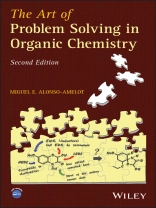This long-awaited new edition helps students understand and
solve the complex problems that organic chemists regularly face,
using a step-by-step method and approachable text. With solved and
worked-through problems, the author orients discussion of each
through the application of various problem-solving techniques.
* Teaches organic chemists structured and logical techniques to
solve reaction problems and uses a unique, systematic
approach.
* Stresses the logic and strategy of mechanistic problem solving
— a key piece of success for organic chemistry, beyond just
specific reactions and facts
* Has a conversational tone and acts as a readable and
approachable workbook allowing reader involvement instead of simply
straightforward text
* Uses 60 solved and worked-through problems and reaction schemes
for students to practice with, along with updated organic
reactions and illustrated examples
* Includes website with supplementary material for chapters and
problems: href=’http://tapsoc.yolasite.com/’>http://tapsoc.yolasite.com
Jadual kandungan
Preface xi
Preface to the First Edition xvii
Acknowledgments xix
1 Problem Analysis in Organic Reaction Mechanism 1
1.1 Overview 1
1.2 Introduction 1
1.2.1 ‘Pushing Forward’ a Solution in Formal and Exhaustive Terms 2
1.2.2 Lessons from this Example 7
1.3 Avoiding the Quagmire 7
1.4 The Basic Steps of Problem Analysis 8
1.4.1 Recognizing the Problem 8
1.4.2 Analyzing Problems by Asking the Right Questions, Discarding the Irrelevant 11
1.4.3 Drawing a First Outline for Guidance 12
1.4.4 Asking the Right Questions and Proposing the Right Answers . . . is enough? 13
1.5 Intuition and Problem Solving 14
1.6 Summing Up 17
References and Notes 17
2 Electron Flow in Organic Reactions 19
2.1 Overview 19
2.2 Introduction 19
2.3 Practical Rules Governing Electron Redeployment 22
2.3.1 Issue 1: Electrons within Orbitals 22
2.3.2 Issue 2: Electron Transfer and Stereochemistry 23
2.3.3 Issue 3: Electron Energy Level and Accessibility 24
2.3.4 Issue 4: Electron Flow and Molecular Active Sectors 26
2.3.4.1 Case A: pi-pi Interactions 26
2.3.4.2 Case B: pi –> sigma Interactions 27
2.3.4.3 Case C: When Reactivity Patterns Seem to Break Down 27
2.3.5 Issue 5: Electron Traffic and Electronic Density Differences 31
2.3.5.1 M° Metals as Electron Source 31
2.3.5.2 Metal Hydrides and Organic Hydrides as Electron Source 32
2.3.6 Issue 6: Creating Zones of High Electron Density 34
2.3.6.1 The Natural Polarization 35
2.3.6.2 Reversing the Natural Polarization: Umpolung 35
2.3.7 Issue 7: Electron Flow and Low Electron Density Zones 36
2.3.7.1 Identifying LEDZs 36
2.3.7.2 Creating a New LEDZ in the Substrate 37
2.3.7.3 Finding Unsuspected LEDZs among the Other Reagents in the Mixture 41
2.3.7.4 When Compounds Show Double Personality 42
2.4 Summing Up 42
2.5 A Flowchart of Organized Problem Analysis 44
References and Notes 45
3 Additional Techniques to Postulate Organic Reaction Mechanisms 49
3.1 Overview 49
3.2 Take Your Time 50
3.3 Clear and Informative Molecular Renderings 50
3.3.1 The Value of Molecular Sketches 50
3.3.2 Two- Versus Three-Dimensional Renderings and the ‘Flat’ Organic Compounds 52
3.4 Element and Bond Budgets 53
3.5 Looking at Molecules from Various Perspectives 55
3.6 Separate the Grain from the Chaff 58
3.7 Dissecting Products in Terms of Reactants: Fragmentation Analysis 59
3.7.1 The Fundamental Proposition 59
3.7.2 Adding Potentially Nucleophilic or Electrophilic Character to Fragments 61
3.7.3 When Fragmentation Analysis Fails Getting Help from Atom Labels 63
3.8 Oxidation Levels and Mechanism 65
3.8.1 Methods to Estimate Oxidation Status 65
3.9 The Functionality Number 66
3.9.1 What Exactly Is FN? 66
3.9.2 Properties of FN 67
3.10 Combining Fragmentation Analysis and Functionality Numbers 72
3.11 Summing Up 74
References 75
4 Solved Problem Collection 77
Problem 1 to 60. See Graphical Problem Index 79
Glossary 405
Subject/Reaction Index 409
Reagent Index 425
Author Index 433
Graphical Problem Index 445
Mengenai Pengarang
Miguel E. Alonso-Amelot is a Professor of Organic and Ecological Chemistry at the Universidad de Los Andes in Venezuela. With over 40 years of teaching experience, he has also led courses on these topics in the US, Europe, and Latin America. His previous research interests include the theory and application of metal carbenoids in cyclopropanes and heterocycles. Currently, he focuses on chemical ecology of tropical mountain ecosystems, and is a consultant on organic chemistry supporting plant natural product bioactivities. Among his publications, Dr. Alonso has written over 90 research articles, five book chapters, and four books, including the First Edition of The Art of Problem Solving in Organic Chemistry, published by Wiley.












